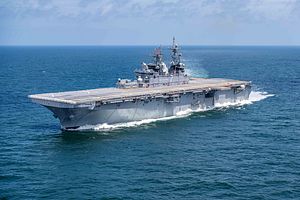The second America-class amphibious assault ship, the future USS Tripoli, designated Landing Helicopter Assault (LHA) 7, successfully completed builder’s trials in the Gulf of Mexico in late July, Huntington Ingalls Industries (HII), the United States’ largest military shipbuilder, announced in a statement on July 22.
The future USS Tripoli spent four days at sea in the Gulf of Mexico, testing the flattop’s main propulsion, combat, and other systems before returning to HII’s shipbuilding division in Pascagoula, Mississippi. The builder’s trials will be followed by acceptance trials and delivery to the U.S. Navy.
The latest America-class amphibious assault ship has been designed to carry the F-35B fighter jet, the U.S. Marine Corps variant of the supersonic fifth-generation F-35 Lightning II Joint Strike Fighter, capable of vertical or short takeoffs and vertical landings without requiring a catapult launcher. It can carry around 10 F-35Bs, in addition to other aircraft.
As I reported previously, in comparison to the first-of-class USS America, the Tripoli features various design upgrades incorporated into the basic build of the flattop, many of which are specifically designed toward carrying and launching the F-35B. These upgrades, including changes to the ship’s flight deck, were incorporated into the basic build of the of the Tripoli as a cost saving measure.
“The flight deck modifications to support the F-35 Joint Strike Fighter aircraft provide an increased aviation capacity and demonstrate how an experienced team can evolve the platform to meet the current threats across the globe,” Ingalls Shipbuilding President Brian Cuccias was quoted as saying in the July 22 statement.
In addition to the F-35B force, the Tripoli can carry four AH-1Z Viper attack helicopters, four CH-53E Super Stallion helicopters, 12 MV-22 Ospreys, and two MH-60S Search and Rescue helicopters.
“Like the lead ship in the class, Tripoli is designed for survivability with increased aviation capacity, including an enlarged hangar deck, realignment and expansion of the aviation maintenance facilities, a significant increase in available stowage for parts and support equipment, and increased aviation fuel capacity,” the press statement reads. “Similar to its predecessors, the ship will be able to operate as the flagship for an expeditionary strike group [ESG].”
The ESG aboard the Tripoli can consist of up to 1,800 U.S. Marines and amphibious warfare equipment. Unlike its immediate predecessor, the Wasp-class, America-class flattops are designed without a well deck that floods to launch landing craft.
The Tripoli was launched in May 2017 and officially christened in September 2017. The U.S. Navy plans for a total force of 11 America-class amphibious assault ships.
The first-of-class USS America is currently underway for training. It is slated to deploy to Japan this year replacing the Wasp-class amphibious assault ship, USS Wasp, as the largest forward-deployed big deck in the U.S. Navy’s 7th Fleet.

































